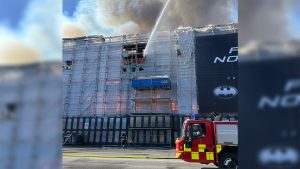The public inquiry into the circumstances under which a 24-storey London, U.K. apartment tower burst into flames in 2017, killing 72 people, resumed after a brief summer recess. Testimony this past month has focussed on the selection process concerning the exterior cladding system.
The Grenfell Tower exterior had been refurbished with ACM (Aluminum Composite Material) panels called Reynobond PE55 that included Celotex RS5000 insulation. The inquiry learned in July that this, in combination with the installation method used over the tower’s block structure, “contributed to the rate and extent of vertical flame spread.”
While several building envelope retrofits are underway or being contemplated in Canada, our codes would not permit the type of cladding system used on the Grenfell Tower on a building of this size and type, according to building envelope specialist Grant Walkin.
What is instructive for Canadian designers and builders, however, are the denials of responsibility being heard in witness testimony.
The decision to use Reynobond ACM panels appears to have taken root after a 2013 meeting between representatives of cladding supplier Harley Facade and architectural firm Studio E.
At the time, Studio E lead architect Bruce Sounces expressed interested in two zinc cladding products, NedZinc and a Proteus panel supplied by German-based KME Architectural Solutions. However, Harley’s commercial manager Mark Harris recommended ACM due to project budget restraints. He later wrote in an email that the suggestion was made “from a Harley selfish point of view,” and based on previous experience with the material.
Inquiry barrister Richard Millett QC questioned Harley’s managing director Ross Bailey on his knowledge and experience with highrise cladding systems and the product and safety regulations surrounding them. Addressing specifically the issue of the cladding specialist’s responsibilities, Millett asked Bailey if “the buck stopped with Harley on products and design.” Bailey replied, “No.”
Bailey described Harley’s input regarding design safety as only one in a “raft of layers.” He named others in the mix, including architect Studio E, fire consultant Exova and Kensington and Chelsea council’s building control officers. Asked about the statutory compliance of Studio E’s designs submitted to his firm, Bailey testified that, “the expectation is that the design is compliant, and we then are producing the production version of the architect’s design.
“We are not statutory compliance experts, so when we have a doubt about how something is done, we seek guidance, and building control are the experts on compliance,” Bailey continued. “We have our designs, and the expertise is in the cladding and how it’s attached to the building, how we get it to site on time, how we make it fit.”
It appears little consideration was given to fire risks associated with the ACM cladding system. Daniel Anketell-Jones, Harley’s design manager, told the inquiry that he himself never considered the combustibility of the Reynobond PE55 panels.
In fact, Anketell-Jones told the inquiry, “There was nobody assigned across the whole company to do that role. Each individual person would look after that responsibility on their own project.”
One of those individuals with responsibilities was Kevin Lamb, a freelance draftsman brought aboard as Grenfell’s “project designer.”
“The first I knew of that (title) was when they (Harley) had some business cards printed up with my name on.”
Harley Facade instead appeared to rely on Celotex’s marketing literature. Bailey testified that Celotex had “made a big, big deal about their products being suitable, specifically designed for buildings over 18m.”
However, the testing referred to by the company in their literature involved installations using cement fibre cladding, not ACM.
In hindsight, this was “very misleading,” Bailey said.
Nevertheless, he testified that Harley sought and received assurances from Celotex that their product was suitable for the ACM system being considered on the Grenfell Tower. Asked if he took Celotex’s assurances on trust, Bailey answered, “Yeah. Why… how… why would they lie to us?”
The inquiry continues and will include important testimony from Celotex.
— With files from Inside Housing and Building.
John Bleasby is a Coldwater, Ont. based freelance writer. Send comments and Legal Notes column ideas to editor@dailycommercialnews.com.










Recent Comments
comments for this post are closed